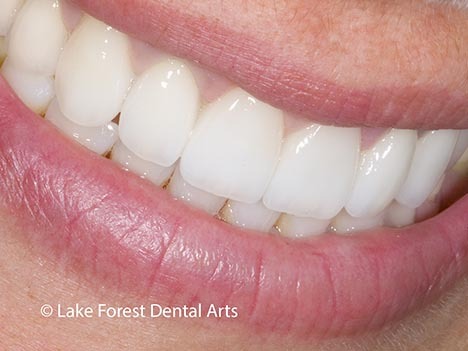 Before
BeforeCosmetic dentistry for discriminating dental clients
 After
AfterCosmetic smile makeover of her upper front teeth
Dramatic dental bridge before and after transformation
Sometimes, it takes an upsetting experience to help people decide to make changes in their path. This patient had been in orthodontics for 6 years. Her general dentist was doing patchwork dentistry on her front teeth that didn’t match. The edges of her new crowns had dark lines at the edges. She wanted what good cosmetic dentistry can provide. She got a second opinion at out office and never looked back. Her treatment included a dental bridge and an assortment of porcelain crowns, and veneers. To make the missing teeth under the bridge appear to be natural, an ovate pontic design was created. We hope the like the treatment results we got with the dental bridge before and after.

The featured smile makeover above is a close up image of the before and after dental bridge transformation including new porcelain veneers.
The most esthetic type of bridge: One that has an ovate pontic
When a dentist creates a fixed bridge, the part that replaces a missing tooth is called a pontic. An ovate pontic is egg shaped where it makes contact with the patient’s gum. If flossing is needed, this shape allows for easy flossing. The ovate pontic is designed to press firmly on the gum. This makes the false tooth look as if it were emerging from the gum.
The ovate pontic does not allow for salvia or air to pass through. Due to the extra work, most dentists just do ovate pontics for bridgework in the front of the mouth. The quality of life is improved if all bridges are designed with an ovate pontic. If possible, Dr. James Fondriest creates ovate pontics for all of the bridges he does.
What is an Ovate Pontic?
When a tooth is lost or never grows in, the gum line will flatten and create a very visible deviation in your smile. The loss of a front tooth can be devastating. Ovate pontics in bridgework help preserve the gum papilla shapes. This in turn preserves the natural gum contours that would have otherwise been lost after extraction. When making a bridge or restoring an implant, special care is required to shape this gum scallop.
The Shape of the Ovate Pontic is Important
A trained cosmetic dentist will shape the underside of the pontic to make the false tooth appear natural. Great care is taken to make sure that the emergence profile of the false tooth appears as if it were a real tooth growing out of the gum and bone. This emergence profile is made to mimic the root form so the tissue scallop shape is natural.
When the dentist takes care to shape the pontic into an egg shape it is called an “ovate pontic”. This applies to a bridge supported by natural teeth or solely by implants. Learning how to reshape the ovate pontic requires advanced training. The less difficult and moer common pontic form is called a ridge lap pontic.
Bridgework is more attractive with the ovate pontic design
The ovate pontic is the most aesthetic pontic design, due to its ability to make the false tooth appear to be growing out of the gum tissue just like the original tooth did. This is especially nice if the bridge is in the front of the mouth and the patient has a big smile. It requires special techniques and training on behalf of the dentist. It is common to require gum grafts to prepare the gum ridge for this cosmetically superior option.
Not only are they more aesthetically pleasing, they often help to ensure overall oral health. When the false tooth is tight to the tissue, there is no space for food to get lodged. If nothing gets under the bridgework, there is less likelihood for tooth decay.
Does a dental bridge require special care before and after treatment?
No! It is just like cleaning regular natural teeth. When the dentist designs the false tooth with an ovate pontic, all you do is brush and floss. Old fashioned bridges required flossing under the bridge. An ovate pontic is fashioned to have the gum grow up to and attach to the underbelly of the pontic.
Flossing would actually break this attachment and cause food to accumulate underneath. If significant gum loss has occurred under the bridge, then flossing will be needed. The same recommendations apply to dental implant supported bridgework.
Learn about and see more dental bridge before and after cases
If you are interested in learning more about replacing missing teeth or ovate pontics, contact our Chicago, IL practice, and schedule a consultation with Dr. Fondriest, by calling 847-234-0517. We hope to provide you with a complete, restorative ovate pontic treatment you can be confident with for years to come.
Dr. Fondriest is a Nationally recognized and highly sought after cosmetic dentist. He serves clients from throughout the United States
